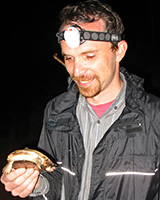"Heidelberg is the Perfect Combination of Beauty and Knowledge"

Dr. Zoltán T. Nagy, zoologist and member of the Joint Experimental Molecular Unit of the Royal Belgian Institute of Natural Sciences, Brussels/Belgium
Doctoral student at the Institute of Pharmacy and Molecular Biotechnology (IPMB) of Heidelberg University from September 1999 to June 2004, returned to Heidelberg in July 2013 within the framework of HAIreconnect
Why did you decide to come to Heidelberg University?
Around 1999 I was starting to think seriously about what I wanted to do after earning my diploma in biology. I had decided on a fairly rare specialisation, herpetology, that I wanted to continue to pursue. Herpetology is the discipline concerned with amphibians and reptiles. I wanted to learn new molecular genetic techniques that would allow me to study and understand the evolution of these animals and how they are related. This was virtually impossible in Hungary at the time, as both the knowledge and the required resources were not available. But you could tell even then that it was an extraordinarily exciting field of research that was just beginning to expand. Scientists of Heidelberg University were at the forefront of this research, and I also knew that biological research was a very important field of activity at the University. So I contacted the University and was able to begin my doctoral thesis in Heidelberg on a DAAD scholarship.
What were your experiences in Heidelberg?
Heidelberg is a city of extraordinary beauty and home to one of the world's most famous universities. In a sense, I found the perfect combination of beauty and knowledge when I came here. The atmosphere at the Institute of Pharmacy and Molecular Biotechnology (IPMB) headed by Prof. Dr. Michael Wink was fairly "vibrating". I had many German and foreign colleagues from very different backgrounds with whom I worked long hours during the day and late into the night and enjoyed many interesting discussions. We solved most problems together and learned a lot from each other. Interestingly, German was still the working language in the lab at the time, so that I was able to improve my language skills. And there is another, private reason why I will never forget Heidelberg: my daughter was born there in 2004.
How did your career continue after your time in Heidelberg?
Shortly after earning my doctoral degree, I accepted a research position in Hungary which, unfortunately, did not meet my expectations regarding good scientific practice. That is why, two years later, I decided to go abroad again. Since 2007, I have been working at the Brussels Museum of Natural History as part of a wonderful research team called Joint Experimental Molecular Unit. Our work covers a wide range of subjects including phylogeny, phylogeography, DNA barcoding and conservation genetics of various animal groups. Over the last few years, we have achieved some spectacular results.
Do you recommend a research visit to Heidelberg University to your students or to colleagues in your scientific network?
My time at Heidelberg University has shaped me to a considerable degree. Even now, nearly 10 years later, I still look back with great fondness on the years I spent there. That is why I regularly recommend Heidelberg University in various forums and feel very honoured to be a Research-Alumni Ambassador for Heidelberg Alumni International (HAI).
Why did you apply to HAIreconnect and what did you do during your stay in Heidelberg?
I never lost contact with Germany; I regularly work with a number of German researchers and institutes such as the Bavarian State Collection of Zoology and TU Braunschweig. Nevertheless, Heidelberg Alumni International offers a unique and direct way of strengthening my ties to Heidelberg University and especially to my former colleagues. The organisation allowed me to spend a week at Heidelberg University in July 2013. The research team of Prof. Wink has a large archive of biological specimens in the form of a tissue sample collection. I used this collection intensively while I was writing my doctoral thesis, and generated molecular genetic data, mainly DNA sequences. Now, almost 10 years later, recent advances in molecular genetics allow us a much more detailed analysis – using new methods of phylogenomics, metagenomics and metabarcoding that are usually based on next generation gene sequencing techniques. Also, Heidelberg offers an excellent combination of knowledge (zoologists, theoretical biologists, software developers etc.) and infrastructure (large collections and well-equipped laboratories). During my brief research stay, I profited from these advantages by participating in inspiring discussions and initiating new projects.

